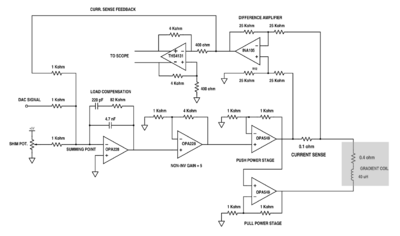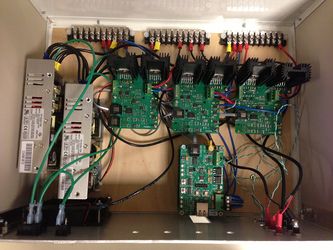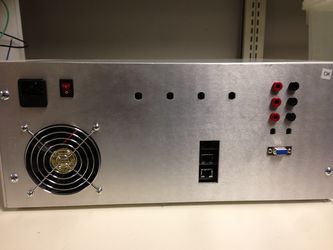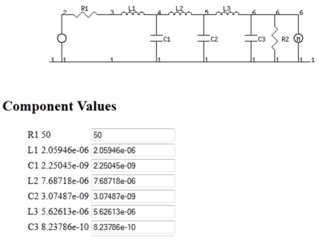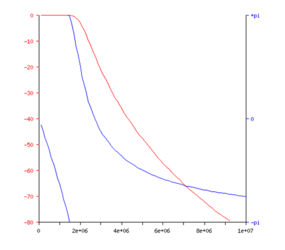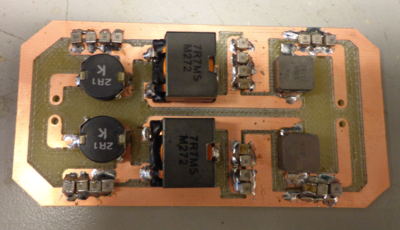Difference between revisions of "Hardware:GPA"
| Line 1: | Line 1: | ||
'''Gradient Power Amplifier''' | '''Gradient Power Amplifier''' | ||
---- | ---- | ||
| − | |||
The gradient amplifier is used to supply the current to the gradient coils. Since it's the fields we care about, and the fields are proportional to current, this amplifier can be viewed as a voltage to current transducer; it takes a voltage waveform from the console and creates a current proportional to that voltage in the gradient coil. It is similar to a common audio power amplifier except that it must also be able to output DC currents. It uses two [http://www.ti.com/lit/ds/symlink/opa549.pdf OPA 549] power op-amps in a bridged configuration. A current sensor compares the output current to the input voltage to ensure that the current itself is proportional to the desired signal. The current sensor consists of an [http://www.ti.com/lit/ds/symlink/ina105.pdf INA105] differential amplifier that measures the voltage across a small (0.1 ohm) resistor in series with the output. The OPA549s can provide up to 8 amps of current, but in practice the current is limited by the duty cycle of the gradient waveform in the pulse sequence and the size of the heat sink used on the boards. | The gradient amplifier is used to supply the current to the gradient coils. Since it's the fields we care about, and the fields are proportional to current, this amplifier can be viewed as a voltage to current transducer; it takes a voltage waveform from the console and creates a current proportional to that voltage in the gradient coil. It is similar to a common audio power amplifier except that it must also be able to output DC currents. It uses two [http://www.ti.com/lit/ds/symlink/opa549.pdf OPA 549] power op-amps in a bridged configuration. A current sensor compares the output current to the input voltage to ensure that the current itself is proportional to the desired signal. The current sensor consists of an [http://www.ti.com/lit/ds/symlink/ina105.pdf INA105] differential amplifier that measures the voltage across a small (0.1 ohm) resistor in series with the output. The OPA549s can provide up to 8 amps of current, but in practice the current is limited by the duty cycle of the gradient waveform in the pulse sequence and the size of the heat sink used on the boards. | ||
| + | |||
| + | |||
| + | == Version 1 of the GPA board == | ||
| + | |||
| + | [[file:Mit_gpa_schematic_V3.png|400px|thumb|right|Figure 1. Gradient Power Amplifier circuit providing a single channel of output current.]] | ||
Revision as of 18:17, 6 August 2016
Gradient Power Amplifier
The gradient amplifier is used to supply the current to the gradient coils. Since it's the fields we care about, and the fields are proportional to current, this amplifier can be viewed as a voltage to current transducer; it takes a voltage waveform from the console and creates a current proportional to that voltage in the gradient coil. It is similar to a common audio power amplifier except that it must also be able to output DC currents. It uses two OPA 549 power op-amps in a bridged configuration. A current sensor compares the output current to the input voltage to ensure that the current itself is proportional to the desired signal. The current sensor consists of an INA105 differential amplifier that measures the voltage across a small (0.1 ohm) resistor in series with the output. The OPA549s can provide up to 8 amps of current, but in practice the current is limited by the duty cycle of the gradient waveform in the pulse sequence and the size of the heat sink used on the boards.
Version 1 of the GPA board
Click here to view the schematic for the GPA boards generated in Eagle (version 6). Note that a separate A/D converter was used in the initial realization of the boards (DAC on the GPAs was not populated).
Email jaystock@nmr.mgh.harvard.edu with any questions.
Click here to download Eagle version 6 board (.brd) and schematic (.sch) files for the V3 GPA board (does not include on-board DAC).
- Gradient Power Amplifier enclosure
Aluminum front panels were made using a water-jet cutter. Hammond NHC-14157 enclosures were used to house the GPAs and DACs. Click here for DXF file for front panel cut-outs
Gradient Filter
6th order butterworth low pass filters were added to the lines leading to the gradients.
The final version of these files can be downloaded as Eagle 5.11.0 and Gerber (for having the boards manufactured).
Note: Inductors were selected based on lead time and inductance and NOT on the package. Any inductor with similar inductance would work. The board was specifically designed for the following: 2.1 uH, 7.7 uH and 5.6 uH.
Note: All capacitor pads are for a 1206 package. There are four pads at each spot to allow for using multiple capacitors to obtain the specified value.
